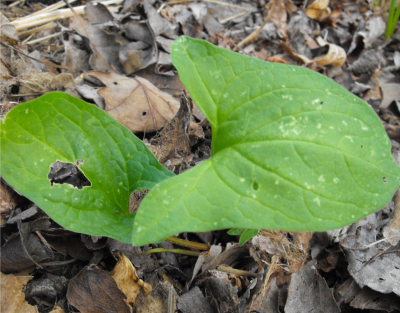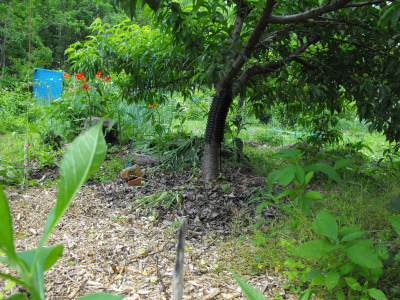
Forest garden islands are easy
 Over
the last year and a half, we've been experimenting with three different
forest gardens. My ambitious
plan to turn the
nectarine-plum-apple area in front of the barn into a forest garden in
one fell swoop has been going as slow as molasses --- I've mostly been
spreading comfrey around for fertility and building a few mounds here
and there to raise plants' roots out of the waterlogged soil. My
low maintenance plan to subtly
tweak a nearby area of young woods to encourage edibles and nectaries is in the growing stage,
with little active management needed.
Over
the last year and a half, we've been experimenting with three different
forest gardens. My ambitious
plan to turn the
nectarine-plum-apple area in front of the barn into a forest garden in
one fell swoop has been going as slow as molasses --- I've mostly been
spreading comfrey around for fertility and building a few mounds here
and there to raise plants' roots out of the waterlogged soil. My
low maintenance plan to subtly
tweak a nearby area of young woods to encourage edibles and nectaries is in the growing stage,
with little active management needed.
The star of the forest
gardening has been my third variation on the theme --- a little forest
garden island
outside the kitchen window, an area that receives our concerted
attention twice a day as we gaze out the window while eating
meals. As a result, I'm often reminded to spend two minutes
pulling weeds or raking back the mulch to throw some flower seeds on
the ground, and the result is a mass of color and fertility that the
central peach seems to enjoy.
 While
the concept of creating a forest garden whole cloth seems pretty
daunting, slowly expanding a forest garden island has turned out to be
easy and fun. A heavy leaf mulch on the compost mounds from last
year resulted in a weed-free area to sow cosmos, marigolds, zinnias,
and other easy flowers this spring. The self-seeded poppies I
transplanted out of the vegetable garden last year are now in full
bloom and the extra Egyptian onion bulblets I tossed beside them are in
just the right spot to make it easy to snip a few leaves for our
dinner. I snuck in a few Good King Henry plants --- a perennial
green that will bear in partial shade --- and randomly poked some giant
pumpkin seeds into the ground.
While
the concept of creating a forest garden whole cloth seems pretty
daunting, slowly expanding a forest garden island has turned out to be
easy and fun. A heavy leaf mulch on the compost mounds from last
year resulted in a weed-free area to sow cosmos, marigolds, zinnias,
and other easy flowers this spring. The self-seeded poppies I
transplanted out of the vegetable garden last year are now in full
bloom and the extra Egyptian onion bulblets I tossed beside them are in
just the right spot to make it easy to snip a few leaves for our
dinner. I snuck in a few Good King Henry plants --- a perennial
green that will bear in partial shade --- and randomly poked some giant
pumpkin seeds into the ground.
 Underneath
the peach's canopy, comfrey continues to grow in the shade, ready to be
cut back to feed the tree's roots. A mass of wood chips
innoculated with King
Stropharia spawn
gives me an easy spot to sit and enjoy the view of swelling
peaches. In my nook under the peach, I feel like I'm immersed in
the woods, but with edibles and flowers within reach. No wonder
our visiting songbirds like to perch in the peach's branches before
flying out into the vegetable garden in search of bugs.
Underneath
the peach's canopy, comfrey continues to grow in the shade, ready to be
cut back to feed the tree's roots. A mass of wood chips
innoculated with King
Stropharia spawn
gives me an easy spot to sit and enjoy the view of swelling
peaches. In my nook under the peach, I feel like I'm immersed in
the woods, but with edibles and flowers within reach. No wonder
our visiting songbirds like to perch in the peach's branches before
flying out into the vegetable garden in search of bugs.
If you're intrigued by
the idea of forest gardening, but are daunted by the extensive planning
and initial work load, I highly recommend starting with a little forest
garden island. A few minutes' play can turn that tree in your
yard into the cornerstone of a vibrant ecosystem, feeding you and the
local wildlife. As the tree grows, so will the understory, and
soon you'll have plenty of perennials to spread under the enlarged
canopy.
| This post is part of our Farm Experiments lunchtime series.
Read all of the entries: |
Want more in-depth information? Browse through our books.
Or explore more posts by date or by subject.
About us: Anna Hess and Mark Hamilton spent over a decade living self-sufficiently in the mountains of Virginia before moving north to start over from scratch in the foothills of Ohio. They've experimented with permaculture, no-till gardening, trailersteading, home-based microbusinesses and much more, writing about their adventures in both blogs and books.
Want to be notified when new comments are posted on this page? Click on the RSS button after you add a comment to subscribe to the comment feed, or simply check the box beside "email replies to me" while writing your comment.

Josh --- That tree in your yard is a great place to start! You'll probably have to work a little harder to get woodland species to move in, since they might not be present in your neighborhood. But you might be surprised what will start turning up once the habitat is right!
I'd probably start simple with a kill mulch of cardboard topped with a heavy mulch of leaves or wood chips, then cut holes to add in a mixture of a few shade-reliable plants like comfrey, maybe alpine strawberries, and currants or gooseberries if you have room. I've seen a few early spring ephemeral bulbs from time to time at Lowes --- any of those could be tucked into the shade.
If you want to jump start your soil ecosystem, you could grab a cup full of leaf mold out of the Crum while you're at Swarthmore and use that to seed your soil!